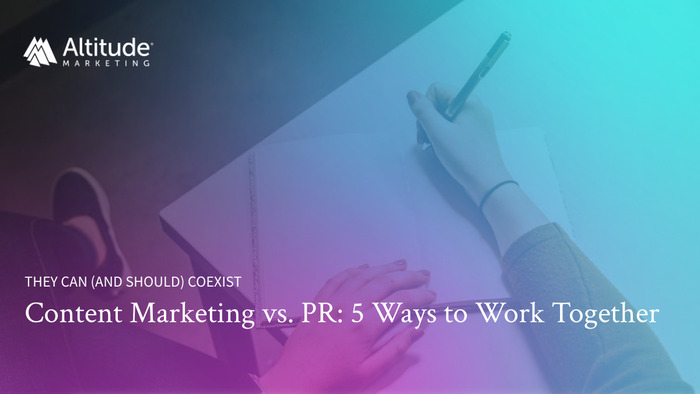Content marketing and public relations play critical roles in a B2B marketing strategy. If budgets are tight, however, does one matter more than the other? More importantly, does the answer change depending on the situation?
People often confuse content marketing with PR. That’s why we’d like to toss out a couple of definitions before we answer the above questions.
(Bear with us. This will be quick. Promise.)
Content marketing basically does what it sounds like it does. It’s a type of marketing that involves creating high-quality digital content that appeals to your target audience. You use the content to attract and convert prospective customers into leads and sales.
PR (Public Relations) is about influencing how the public perceives your product and/or company. Usually, it involves distributing press releases and other content, hoping that media outlets will use that content to inform the stories they report. PR can also involve crisis and reputation management, event management, speaking opportunities, and awards.
Though PR and content marketing involve slightly different tools and tactics, both can help you increase brand awareness, thought leadership, and customer demand. The trick: Create PR and marketing plans that complement one another rather than compete with one another. Below you’ll find five steps that will help you to do just that.

5 Steps for Superpowered Content Marketing and Public Relations
- Produce Great Content
- Promote Your Content to the Media
- Use PR-Driven Relationships to Boost SEO-Driven Content
- Follow and Interact with Influencers and Journalists
- Partner with Influencers
1. Produce Great Content
Many B2B companies make a mistake with content marketing: They include a hard or soft sell in the copy.
Content marketing isn’t about promoting your company, and it’s not about making the sale.
(That’s the job of your sales team.)
Rather, it’s about building a community of people interested in your company and who see it as a leader in the field. To do that, you don’t need hardcore sales tactics; Rather, you want informative, helpful, inspiring, and/or entertaining content. (Need ideas? Check out this list of ways to come up with fresh content.)
Use the chart below to explore several types of content you can use for marketing purposes.
| Content Type | Description | Benefits |
| SEO-driven articles | Web articles that revolve around common keywords that your target customers tend to type into a search engine. Usually, SEO articles help educate, answer questions, and solve problems for your target audience. |
⬆️Website traffic ⬆️Brand awareness ⬆️Leads |
| Videos | Customer stories, product reviews, webinars, product demos, live streaming, tutorials, explainers, and behind-the-scenes takes that are posted to your website and/or social media channels. |
⬆️Brand awareness ⬆️Sales ⬆️Website traffic and dwell time |
| Infographics | Large, eye-catching visuals that tell a story by combining short snippets of information with charts, tables, illustrations, and fun icons. |
⬆️Brand reputation ⬆️ Thought leadership ⬆️Leads |
| Entertaining visuals | Memes and GIFs created for social media. |
⬆️Social sharing ⬆️Brand awareness ⬆️Likes and follows |
| Case studies | Tells the story about a specific client whose problem was solved by your B2B product or service. |
⬆️Social proof ⬆️Leads |
| White papers and eBooks | Longform, sometimes technical, articles that offer valuable advice, data, and/or information. |
⬆️Leads ⬆️Thought leadership ⬆️Brand awareness |
(FREE Download: Use Our Workbook to Plan Your Content Strategy.)
2. Promote Your Content to the Media
In the past, PR mostly involved sending out press releases to major media outlets like newspapers and television shows. Though press releases are still important, the Internet age has improved PR.
Today’s digital PR strategies are about building relationships with online bloggers and social media influencers. When these folks put your content in front of their audiences, it increases your reach, brings in new prospects, and massively boosts brand awareness and trust.
3. Use PR-Driven Relationships to Boost SEO-Driven Content
Your relationships with bloggers can help in yet another way: By earning you high-authority backlinks.
When large, trusted, relevant websites link to your content, it does more than build a path for visitors to travel to it. When search engines like Google decide where to place your site on a search engine results page (SERP), they consider inbound links. The more links coming to your website from other high-domain authority sites, the greater your chances of appearing on page one.
This begs the question: How do you get backlinks? Step Two from above will help. That’s because, when sites write stories about your content, they usually link to it. Another option: Sign up for a service like Help a Reporter Out or Qwoted, which alert you when journalists are looking for experts to interview on various topics. If the outlet is digital and someone at your company is a good fit, you’ll end up with an excellent backlink.
(Related: 13 Content Marketing Trends for 2023.)
4. Follow and Interact with Influencers and Journalists
Think of this like networking – and not as self-promotion.
This isn’t about peppering a journalist’s feed with “Hey, look at me! Look at me! Do you know what I do?” comments. That will likely just annoy them. Instead, interact as if you’re a fan.
You continually put your company in front of journalists’ minds by commenting on their posts and sharing their content. That way, when a journalist is working on a story that requires an expert with your company’s experience, they’ll be more likely to reach out.
(Read more: Working with Influencers, Plus Other Social Media Trends.)
5. Partner with Influencers
Most people trust recommendations from other people rather than from companies. So getting an “in” from an influencer can help you overcome the long and more difficult sales cycles of B2B.
This involves more than merely networking. Money will need to exchange hands. After all, this is precisely how many influencers earn a living.
Influencer marketing, however, doesn’t have to break your budget.
Rather than only reaching out to mega-influencers with millions of followers, budget-conscious B2B companies focus on micro-influencers. These folks have much smaller followings, which usually means they charge less. Yet, a recommendation from a micro-influencer can be just as powerful as one from a macro-influencer. That’s because their audiences tend to be more engaged, with nearly half making a purchase upon that influencer’s recommendation. Micro-influencers are more likely to have audiences composed of people who can benefit from what you offer.
So, how do you reach your industry’s influencers?
You’ve probably already done some legwork, which starts with developing a B2B buyer persona to understand your target audience. Research publications and organizations industry professionals are members of. Meet with industry players at trade shows to form relationships. Explore LinkedIn to see who interacts with each other in relevant conversations.
Choose an influencer who…
- Writes and talks about things that relate to what you’re selling.
- Is trusted in their space.
- Has an engaged community with a solid percentage of people likely to want your product.
- Doesn’t say or do things that could damage your company’s reputation.
Conclusion: Know Your Company’s Needs
We just laid out five steps to help you pair content marketing with public relations, so you can leverage both and get better results.
That said, let’s circle back to the original question: Which is more important?
The truth is, there will be times when one is more important than the other. To suss that out, you’ll want to know what you’re trying to accomplish. The chart below can help.
| Choose content marketing if you want… | Choose PR if you want to… | Combine content marketing and PR if you want to… |
more leads increased brand awareness |
repair your company’s reputation sway the public’s view of your company |
amplify your content ensure your brand’s message is consistent use SEO to deliver qualified prospects and leads expand your audience in the digital space |




